The AMD Ryzen 5 1600X vs Core i5 Review: Twelve Threads vs Four at $250
by Ian Cutress on April 11, 2017 9:00 AM ESTBenchmarking Performance: CPU Web Tests
One of the issues when running web-based tests is the nature of modern browsers to automatically install updates. This means any sustained period of benchmarking will invariably fall foul of the 'it's updated beyond the state of comparison' rule, especially when browsers will update if you give them half a second to think about it. Despite this, we were able to find a series of commands to create an un-updatable version of Chrome 56 for our 2017 test suite. While this means we might not be on the bleeding edge of the latest browser, it makes the scores between CPUs comparable.
SunSpider 1.0.2 [link]
The oldest web-based benchmark in this portion of our test is SunSpider. This is a very basic javascript algorithm tool, and ends up being more a measure of IPC and latency than anything else, with most high performance CPUs scoring around about the same. The basic test is looped 10 times and the average taken. We run the basic test 4 times.
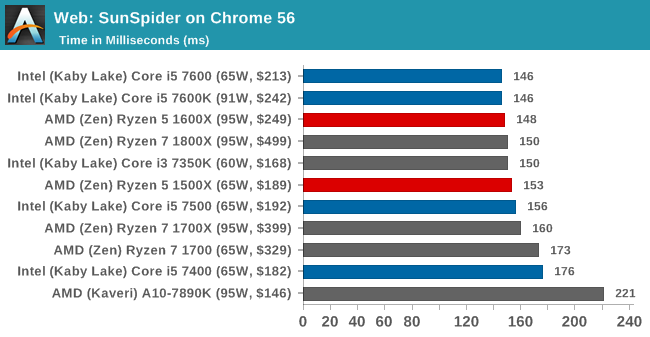
Mozilla Kraken 1.1 [link]
Kraken is another Javascript based benchmark, using the same test harness as SunSpider, but focusing on more stringent real-world use cases and libraries, such as audio processing and image filters. Again, the basic test is looped ten times, and we run the basic test four times.
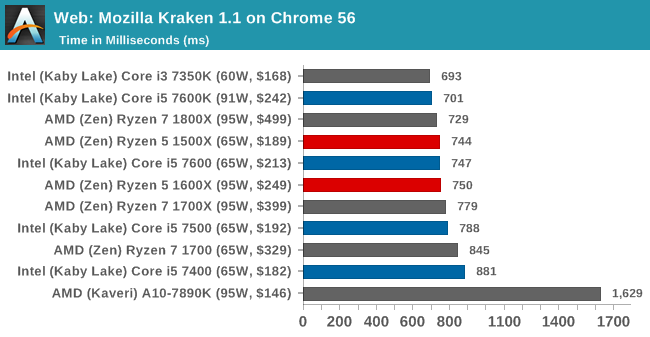
Google Octane 2.0 [link]
Along with Mozilla, as Google is a major browser developer, having peak JS performance is typically a critical asset when comparing against the other OS developers. In the same way that SunSpider is a very early JS benchmark, and Kraken is a bit newer, Octane aims to be more relevant to real workloads, especially in power constrained devices such as smartphones and tablets.
WebXPRT 2013 and 2015 [link]
While the previous three benchmarks do calculations in the background and represent a score, WebXPRT is designed to be a better interpretation of visual workloads that a professional user might have, such as browser based applications, graphing, image editing, sort/analysis, scientific analysis and financial tools. Web2013 is the older tool, superceded by Web2015, however both still are highly relevant for high-performance web applications today.
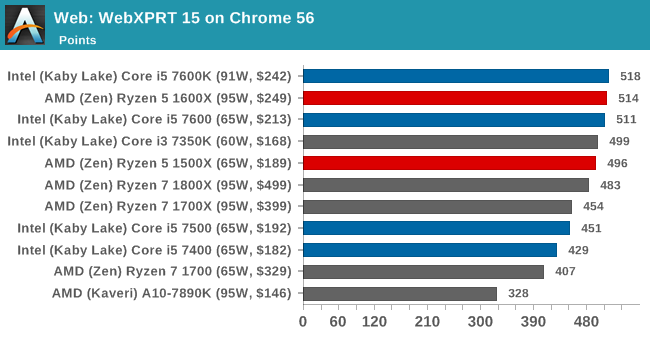


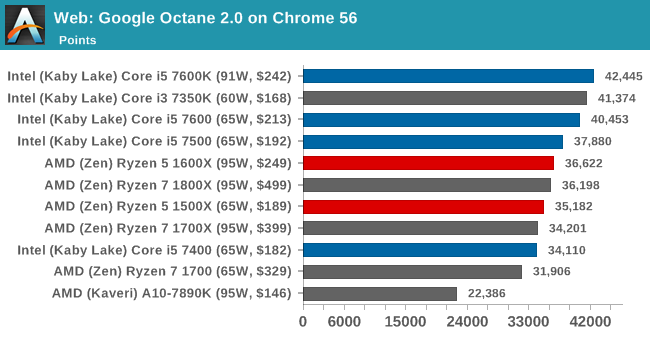
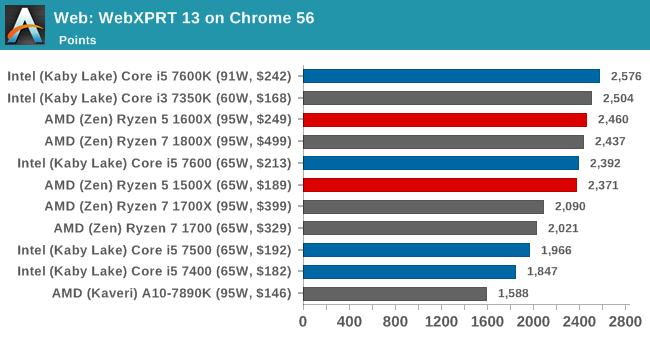








254 Comments
View All Comments
Kamgusta - Tuesday, April 18, 2017 - link
Are you replying to me? I talked about i7-7700 (NOT K), not i7-7700K.Which cope very well with some budget DDR4-2400MHz and a budget H270 board with no penalties whatsoever.
msroadkill612 - Wednesday, May 3, 2017 - link
Interesting. ta for sharing. pretty awesome price for the 1600/mobo bundle.How did the intel mobo compare for functionality do u think?
loguerto - Friday, April 21, 2017 - link
9 is not prime :)LawJikal - Friday, April 21, 2017 - link
What I'm surprised to see missing... in virtually all reviews across the web... is any discussion (by a publication or its readers) on the AM4 platform's longevity and upgradability (in addition to its cost, which is readily discussed).Any Intel Platform - is almost guaranteed to not accommodate a new or significantly revised microarchitecture... beyond the mere "tick". In order to enjoy a "tock", one MUST purchase a new motherboard (if historical precedent is maintained).
AMD AM4 Platform - is almost guaranteed to, AT LEAST, accommodate Ryzen "II" and quite possibly Ryzen "III" processors. And, in such cases, only a new processor and BIOS update will be necessary to do so.
This is not an insignificant point of differentiation.
systemBuilder - Friday, April 28, 2017 - link
I believe the Ryzen core is 20% slower than the Intel core, in instructions per clock. A hyperthread is only about 30% as fast as a full core. With both of these factors thrown in, 6 Ryzen Cores = 5 Intel cores. So the advantage of Ryzen is actually miniscule. It's why I sold all of my AMD stocks in February.willis936 - Thursday, July 27, 2017 - link
"sold all of my AMD stocks in February"I'm cringing.
systemBuilder - Friday, April 28, 2017 - link
Ryzen's cores are 20% slower than Intel's. A hyperthread is only worth (at best) 30% as much as a full core. Therefore, Intel offers 4 cores, AMD offers 6 * 0.8 * 1.3 = 6.24 cores, a decent bump but obviously not significant because few if any games are set up to use more than 8 cores, which in the best case for AMD would be (6 + 0.3 + 0.3)*0.8 = 5.28 cores, a small bump.Cooe - Monday, March 1, 2021 - link
Except Zen 1 was only about ≈5% slower in IPC vs Kaby Lake, not 20%...msroadkill612 - Monday, May 1, 2017 - link
Some thoughts from a ~newb, are that if 8 cores are the new black, then maybe 16GB (or 2GB per core) of ram, isnt as generous as it seems?Also, its a new paradigm. Tasks which taxed the cpu and thus historically avoided (software raid e.g.), can now be embraced with ~impunity.
"Normal" CPUs can handle 16 jobs before a queue forms, commonly, an increase by a factor of 8 for a prospective upgrader.
Gothmoth - Tuesday, May 2, 2017 - link
"...affords a comfortable IPC uplift over Broadwell....."yeah does it?
what is comfortable??.... 10%.... who are you trying to kid here?